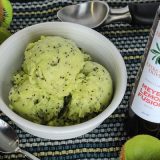Meyer Lemons Add Cheer to Winter Woes
Meyer Lemons Add Cheer to Winter Woes
By Robbie Sigona

Meyer lemons are a favorite among backyard gardeners, amateur gourmands and renowned chefs alike for their high juice content and much more.
Most Californians who know Meyer lemons go gaga over them. Have you noticed? Some daring, Meyer-loving customers will buy a Meyer lemon and bite into it – just like it’s an apple – before they even reach their car! To unfamiliar bystanders, this may look like self-inflicted torture – who would want to bite into a sour, bitter lemon!? Well, the Meyer lemon is hardly a typical lemon. While it carries some of lemon’s tart flavor, the Meyer is in a league of its own.
Meyer lemons are a favorite among backyard gardeners, amateur gourmands and renowned chefs alike for their beautiful, egg-yolk yellow color, their smooth, thin, edible & aromatic peel, their high juice content, and, most of all, their unique tart-sweet flavor.
Most Meyer lemons are generally found only in specialty produce markets or growing in your neighbor’s backyard. They don’t often make it to supermarket shelves, and it’s their thin skin that’s kept them a “local secret” for so long. Meyer lemons are too delicate and fragile to ship long distances.
We bring in Meyers from all over California. Most come from the San Joaquin Valley, but from January to April we get them from Redwood City, San Carlos and Atherton…you can’t get much more local than that! In fact, some of what we carry come from our customers who grow and care for Meyer lemon trees in their own backyards.
The Meyer lemon, which thrives in California, Texas and Florida, was originally thought to be a cross between a lemon and a mandarin, but recent DNA testing found it to be a cross between a lemon and a sweet orange. The variety was introduced in 1908 to the United States by Frank Meyer, a USDA commissioned plant explorer, who discovered the variety while on a plant expedition in China. This lemon, which now bears his name, is just one of the more than 2,500 plants he introduced to the U.S. before he died in 1918 in Shanghai, China.

Meyer lemons have a beautiful, egg-yolk yellow color, smooth & thin peels, high juice content and a unique tart-sweet flavor.
Meyer lemons nearly vanished from the United States in the mid 1900s due to a virus they carried that infected other lemon trees. However, thanks to some modifications, the Meyer lemon tree is now virus free and has been reapproved for cultivation throughout citrus-growing regions.
Lemons play an important roll in Sicilian cuisine – important enough that lemons are one of the three produce items featured on our new logo. The lemons that grow in Sicily are sweeter, much like Meyer lemons, and, as a kitchen staple, they are incorporated into everything from entrees to desserts and beverages. No discussion of Sicilians and lemons is complete without highlighting their beloved cookies and cakes, such as Cassata, which is made with candied lemon peel. Then, of course, there’s Sicily’s signature drink: Limoncello, a liqueur made from vodka and lemon juice. It’s usually chilled and served on a hot summer day.
It’s the low acidity and sweet flavor of the Meyer lemon that makes them more ideal for desserts and lemonade than the usual lemon varieties, such as the Lisbon or Eureka. However, don’t stop stretching your cooking creativity at the lemonade stand! We’ve found many websites dedicated to the endless uses of Meyer lemons, such as this 2006 article in the Los Angeles Times titled, “100 things to do with a Meyer lemon.” This list is especially handy if you, like Christine, our marketing manager, have a Meyer lemon tree in your backyard.
We have more Meyer lemon recipes here, including one for an absolutely terrific homemade lemon curd. Enjoy!









